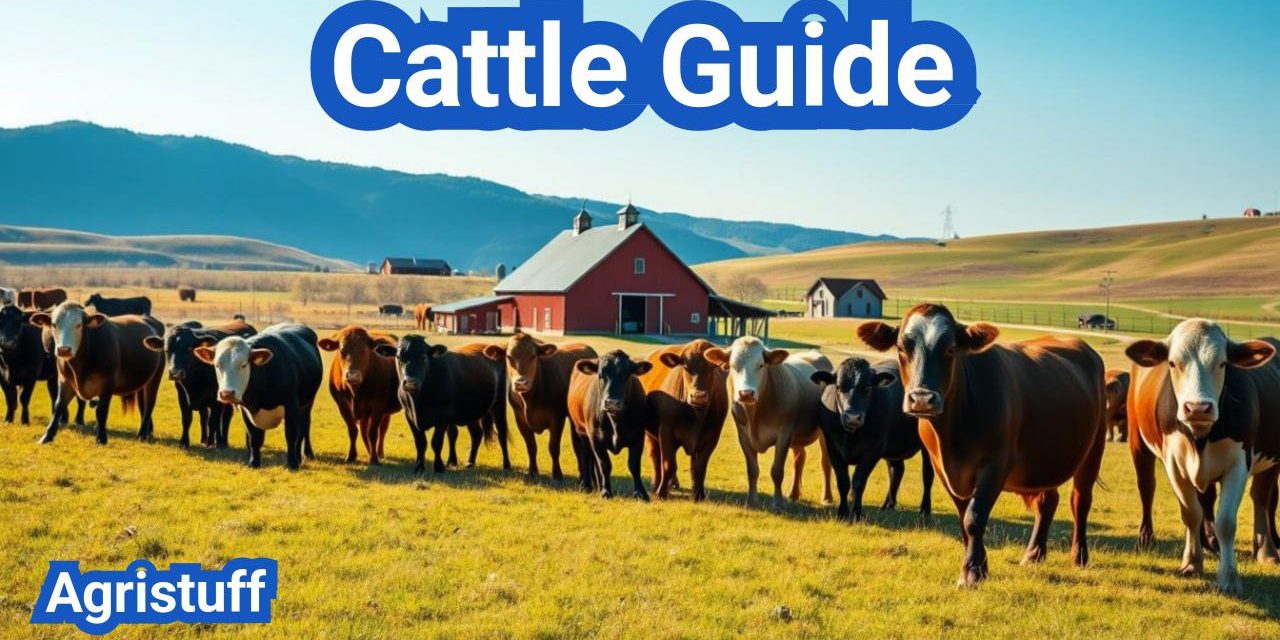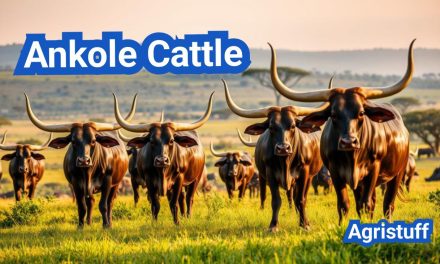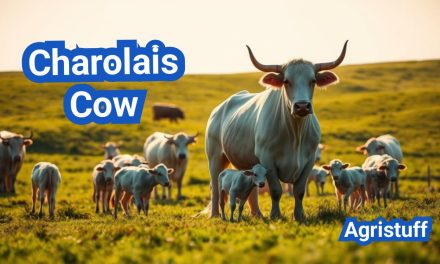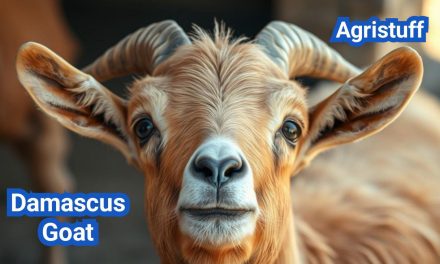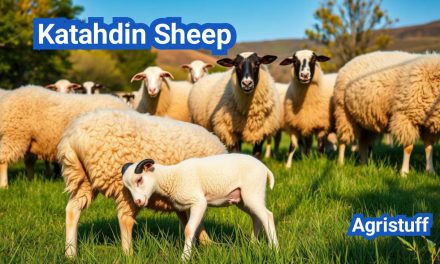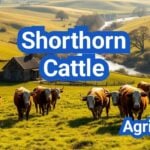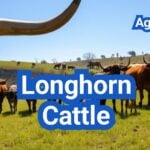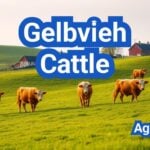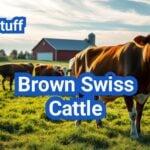The world of livestock is diverse, with over 1000 breeds of cattle worldwide, each having unique characteristics and uses. The significance of cattle in agriculture cannot be overstated, as they provide essential products such as meat, milk, and leather.
From beef cattle breeds to dairy cattle breeds, the variety is vast, catering to different farming practices and consumer demands. Sustainable cattle farming has become increasingly important, focusing on animal welfare and environmental stewardship.
Key Takeaways
- Over 1000 breeds of cattle exist worldwide.
- Cattle are used for various products, including meat, milk, and leather.
- Beef and dairy cattle breeds serve different purposes.
- Sustainable farming practices are becoming more prominent.
- Cattle welfare is a critical aspect of modern farming.
Understanding Cattle: Domestication and Importance
The domestication of cattle is a pivotal event in human history, influencing agriculture, culture, and economies worldwide. Cattle have been domesticated for thousands of years, with various breeds developed for different purposes such as milk, meat, and labor.
The History and Domestication of Cattle
The domestication of cattle dates back to around 10,000 years ago in the Fertile Crescent, a region that includes modern-day Iraq, Syria, Lebanon, Jordan, Israel, and parts of Turkey and Egypt. The process involved the domestication of wild aurochs (Bos primigenius), which were gradually bred into the diverse range of cattle breeds we see today.
This domestication had a significant impact on human societies, enabling the development of settled agriculture and the growth of complex societies. Cattle provided a reliable source of food, clothing, and labor, revolutionizing human life and culture.
Cattle Terminology: Bulls, Cows, Heifers, and Calves
Understanding cattle terminology is essential for anyone involved in the livestock industry. Key terms include bulls, which are intact male cattle; cows, which are adult female cattle that have given birth; heifers, which are female cattle that have not yet given birth; and calves, which are young cattle of either sex.
Other important terms include steers (castrated male cattle) and oxen (castrated males used for draft purposes). Familiarity with these terms is crucial for effective communication and management in cattle farming.
The Global Significance of Cattle
Cattle play a vital role in many cultures and economies around the world. In some societies, cattle are considered sacred or hold significant cultural and religious importance. Economically, cattle are a major source of income for many communities, providing meat, milk, hides, and draft power.
Globally, the cattle industry is a significant contributor to agricultural economies, with millions of people relying on cattle for their livelihood. The industry is also a major player in international trade, with cattle products being exported and imported worldwide.
Types of Cattle: Classification and Characteristics

Understanding the different types of cattle is essential for farmers and livestock enthusiasts alike. Cattle have been domesticated for thousands of years, leading to a diverse range of breeds with unique characteristics.
Bos Taurus (European Cattle)
Bos Taurus, commonly known as European cattle, are one of the primary types of cattle. They are known for their high-quality beef and dairy production. Bos Taurus breeds are often preferred in temperate climates due to their adaptability and productivity.
Some notable characteristics of Bos Taurus include:
- Higher marbling scores, which contribute to tender and flavorful beef
- Generally better suited to cooler, temperate climates
- Popular breeds include Angus, Hereford, and Simmental
Bos Indicus (Zebu Cattle)
Bos Indicus, or Zebu cattle, are known for their heat tolerance and resistance to certain diseases. They are predominantly found in tropical and subtropical regions. Bos Indicus breeds are characterized by their distinctive hump and large ears.
Key characteristics of Bos Indicus include:
- High heat tolerance, making them suitable for hot climates
- Resistance to certain parasites and diseases
- Breeds such as Brahman are widely used in tropical regions
Hybrid Varieties and Crossbreeds
Hybrid cattle are the result of crossbreeding between different breeds or types, such as between Bos Taurus and Bos Indicus. These hybrids often combine the beneficial traits of both parents, such as heat tolerance and high productivity.
| Type | Characteristics | Advantages |
|---|---|---|
| Bos Taurus | High-quality beef and dairy, temperate climate adaptability | High productivity, tender beef |
| Bos Indicus | Heat tolerance, disease resistance | Suitable for hot climates, parasite resistance |
| Hybrid/Crossbreeds | Combination of traits from parent breeds | Balanced productivity and adaptability |
In conclusion, understanding the different types of cattle is crucial for making informed decisions in cattle farming. Whether it’s Bos Taurus, Bos Indicus, or hybrid varieties, each type has its unique characteristics and advantages.
Popular Beef Cattle Breeds
Among the many beef cattle breeds, some have gained popularity for their exceptional traits. These breeds have been developed over centuries to excel in various environments and production systems.
Angus Cattle: Characteristics and Benefits
Angus cattle are renowned for their high-quality beef, known for its marbling, tenderness, and flavor. Originating from Scotland, Angus cattle have become a global favorite among beef producers due to their hardiness and ability to thrive in different conditions.
Key Characteristics:
- High marbling score, contributing to tender and flavorful beef
- Black coat, although red Angus exist, they are less common
- Adaptability to various climates and production systems
Hereford Cattle: The Efficient Grazers
Hereford cattle are another popular breed, celebrated for their efficiency in grazing and beef production. They are known for their hardiness and rapid growth rate, making them a favorite among ranchers.
Efficient grazing capabilities allow Herefords to thrive on pasture, converting grass into high-quality beef effectively.
| Breed | Origin | Key Traits |
|---|---|---|
| Angus | Scotland | High marbling, hardy |
| Hereford | England | Efficient grazers, fast growth |
Wagyu Cattle: Premium Beef Production
Wagyu cattle are prized for their exceptional beef quality, characterized by intense marbling and a rich, buttery flavor. Originating from Japan, Wagyu cattle are now raised worldwide to meet the demand for premium beef.
The unique genetics of Wagyu cattle result in premium beef that commands a high price in the market.
Charolais and Simmental Cattle
Charolais cattle and Simmental cattle are two other significant beef cattle breeds. Charolais, originating from France, is known for its rapid growth rate and lean meat production. Simmental, from Switzerland, is appreciated for its fast growth and high milk production, making it suitable for both beef and dairy production.
Both breeds are valued for their growth rates and production efficiency, contributing to their popularity in the beef industry.
Essential Dairy Cattle Breeds

Essential dairy cattle breeds play a crucial role in meeting the global demand for milk and dairy products. These breeds have been developed over centuries to optimize milk production, with various characteristics that make them suitable for different dairy farming operations.
Holstein Friesian: The High-Volume Producers
The Holstein Friesian is one of the most recognizable dairy cattle breeds worldwide, known for its high milk production. Originating from the Netherlands, this breed is widely used in dairy farming due to its ability to produce large quantities of milk. Holstein Friesians are black and white, with a mature cow weighing between 1,100 and 1,500 pounds. Their milk production averages around 22,000 pounds per year, making them a popular choice for large-scale dairy operations.
Jersey Cattle: Quality Over Quantity
Jersey cattle, originating from the Channel Island of Jersey, are renowned for their rich milk, which has a high butterfat content. This breed is smaller than Holstein Friesians, with mature cows weighing around 800-1,200 pounds. Despite their lower milk production volume compared to Holsteins, Jerseys are prized for the quality of their milk, which is ideal for producing cheese and butter.
Guernsey and Brown Swiss Cattle
Guernsey cattle, another Channel Island breed, are known for their rich, creamy milk and distinctive fawn and white coloring. They are efficient milk producers, with a high butterfat content, making their milk ideal for dairy products. Brown Swiss cattle, originating from Switzerland, are known for their longevity and high milk production. They are robust and adaptable, making them suitable for various dairy farming systems.
Ayrshire and Friesian Cattle
Ayrshire cattle, hailing from Scotland, are known for their hardiness and efficiency in milk production. They are medium-sized, with a red and white coat, and are recognized for their ability to produce high-quality milk. Friesian cattle, closely related to Holstein Friesians, are also significant in dairy farming, particularly in regions where their specific characteristics are valued.
The selection of dairy cattle breeds depends on various factors, including climate, farm management practices, and market demand. Understanding the characteristics of different breeds is crucial for dairy farmers to make informed decisions that optimize their milk production and overall farm efficiency.
Heritage and Specialty Cattle Breeds
Exploring heritage and specialty cattle breeds reveals a rich tapestry of agricultural heritage and innovation. These breeds, often characterized by their unique physical characteristics and historical significance, play a vital role in preserving genetic diversity and cultural heritage.
Highland Cattle: The Hardy Mountain Breed
Highland cattle are renowned for their hardiness and ability to thrive in challenging environments. Originating from the Scottish Highlands, these cattle are well-adapted to rugged terrains and harsh weather conditions. Their thick coats and robust constitution make them an ideal choice for farmers looking for a low-maintenance breed.
Longhorn Cattle: Historic American Breed
Longhorn cattle are a symbol of American history and are known for their distinctive horns and hardiness. Originally brought to the Americas by Spanish settlers, Longhorns have become an integral part of the country’s cattle heritage. They are prized for their ability to thrive in a variety of conditions and their lean beef.
Belted Galloway: The “Oreo Cookie” Cows
Belted Galloway cattle are easily recognizable due to their unique belted appearance, which has earned them the nickname “Oreo Cookie” cows. This breed is known for its high-quality beef and is often used in crossbreeding programs to improve the marbling and flavor of beef cattle.
Ankole Cattle: The Impressive Horned Breed
Ankole cattle are known for their impressive horns, which can span up to 6 feet from tip to tip. Originating from Africa, this breed is valued for its heat tolerance and resistance to disease. Ankole cattle are also prized for their lean meat and are often used in conservation grazing programs.
| Breed | Origin | Notable Characteristics | Use |
|---|---|---|---|
| Highland | Scottish Highlands | Thick coat, hardy | Beef production |
| Longhorn | America | Distinctive horns, lean beef | Beef production, historical significance |
| Belted Galloway | Scotland | Belted appearance, high-quality beef | Beef production, crossbreeding |
| Ankole | Africa | Impressive horns, heat tolerance | Conservation grazing, lean meat |
Miniature Cattle Varieties for Small Farms

The appeal of miniature cattle lies in their ability to thrive on smaller plots of land, making them ideal for small farms. These compact animals offer a range of benefits, from lower feed costs to easier handling, making them an attractive option for farmers with limited space.
Mini Highland Cows and Miniature Highland Cattle
Mini Highland cows are a popular choice among small farm owners. They retain the hardiness and ruggedness of their full-sized counterparts but require less land and feed. Their gentle nature and striking appearance make them a favorite among farmers and hobbyists alike.
Miniature Highland cattle are known for their rich, high-quality milk and beef production. Despite their smaller size, they are efficient converters of feed into high-quality products, making them a valuable asset to small farming operations.
Dexter Cattle: The Original Mini Breed
Dexter cattle are recognized as one of the original miniature breeds. Originating from Ireland, they have been prized for their compact size, hardiness, and versatility. Dexters are known for their rich milk and high-quality beef, making them a dual-purpose breed that is highly valued on small farms.
Their small size and docile nature make Dexter cattle easy to manage, even for those new to cattle farming. They are also efficient foragers and can thrive on a variety of grazing conditions.
Micro Cows and Other Miniature Cattle Options
In addition to Mini Highland and Dexter cattle, there are other miniature cattle options available, including micro cows. These extremely compact animals are perfect for very small farms or even backyard farming operations. Micro cows still provide the benefits of cattle, such as milk and beef, but on a much smaller scale.
Farmers considering miniature cattle should research the specific needs and characteristics of each breed to determine which best suits their operation. Factors such as climate, available land, and the farmer’s experience level should all be taken into account.
Unique and Specialized Cattle Breeds

The diversity in cattle breeds is remarkable, with certain breeds being recognized for their exceptional qualities and uses. These unique and specialized breeds have been developed to cater to specific needs in cattle farming, ranging from beef and dairy production to draft purposes.
Belgian Blue: The Double-Muscled Breed
The Belgian Blue breed is renowned for its double-muscling trait, which results from a genetic mutation. This characteristic makes them exceptionally muscular, with a higher yield of lean meat. Belgian Blues are primarily used for beef production, prized for their tender and lean meat.
Brahman Cattle: Heat-Tolerant Specialists
Brahman cattle are well-known for their heat tolerance and resistance to insects, making them ideal for farming in hot and humid climates. Originating from India, Brahman cattle have been crossbred with other breeds to improve their hardiness and productivity. They are used in various cattle operations, including beef production.
Piedmontese and Beefmaster Cattle
Piedmontese cattle, originating from Italy, are recognized for their lean meat and are often used in crossbreeding programs to improve meat quality. Beefmaster cattle, on the other hand, are a composite breed developed for their heat tolerance and growth rate. Both breeds are valued for their unique characteristics and contributions to cattle farming.
Fluffy Cows and Other Notable Varieties
Fluffy cows, such as the Highland cattle, are admired for their shaggy coats and hardiness. Other notable breeds include those with unique coat patterns or colors, such as the Belted Galloway. These breeds not only contribute to the genetic diversity of cattle but also offer aesthetic appeal.
| Breed | Characteristics | Primary Use |
|---|---|---|
| Belgian Blue | Double-muscled, lean meat | Beef Production |
| Brahman | Heat-tolerant, insect-resistant | Beef Production, Crossbreeding |
| Piedmontese | Lean meat | Beef Production, Crossbreeding |
| Beefmaster | Heat-tolerant, fast growth rate | Beef Production |
How to Start Cattle Farming

To successfully start cattle farming, it’s crucial to assess your resources, understand your land’s potential, and select a suitable breed. Cattle farming is a significant agricultural venture that requires careful planning and execution.
Assessing Land Requirements and Facilities
The first step in starting a cattle farm is to assess your land. The size and quality of your land will determine the number of cattle you can raise. It’s essential to ensure that your land has adequate grazing and sufficient water supply.
Key Considerations for Land Assessment:
- Land size and topography
- Grazing quality and quantity
- Water availability and quality
- Fencing and infrastructure
Selecting the Right Cattle Breed for Your Goals
Choosing the right cattle breed is vital for the success of your farm. Different breeds are suited for different purposes, such as beef production, dairy farming, or draft purposes.
| Breed | Purpose | Characteristics |
|---|---|---|
| Angus | Beef | High-quality beef, hardy |
| Holstein Friesian | Dairy | High milk production |
| Hereford | Beef | Efficient grazers, fast growth rate |
Essential Equipment and Resources
Once you have selected your land and breed, you’ll need to acquire the necessary equipment and resources. This includes fencing, feeding equipment, and veterinary supplies.
Initial Investment Considerations:
- Fencing and enclosures
- Feeding and watering equipment
- Veterinary care and supplies
- Handling facilities
Cattle Uses in Modern Agriculture
The versatility of cattle in modern agriculture is undeniable, with their uses ranging from beef and dairy production to draft animals. Cattle have been a cornerstone of agricultural practices for centuries, providing a multitude of products and services that are essential to both the economy and society.
Beef Production Systems and Methods
Beef production is one of the most significant uses of cattle in modern agriculture. Various systems are employed, including grass-fed, grain-fed, and mixed systems. Grass-fed beef production is often associated with more natural and sustainable practices, while grain-fed systems can produce beef more quickly. The choice of system depends on factors like climate, available land, and market demand.
“The cattle industry is a complex and multifaceted sector that requires careful consideration of various factors, including animal welfare, environmental impact, and consumer preferences,” as noted by agricultural experts.
Dairy Operations and Milk Production
Dairy cattle are bred specifically for their ability to produce high volumes of milk. Modern dairy operations range from small, family-owned farms to large, industrial-scale facilities. Advances in breeding, nutrition, and milking technology have significantly increased milk production efficiency. Holstein Friesian cattle, for example, are renowned for their high milk production capabilities.
Draft Animals and Other Practical Uses
In addition to beef and dairy production, cattle are used as draft animals in many parts of the world. Oxen, for instance, are still used for plowing fields and transporting goods in areas where mechanized equipment is not feasible or is too expensive. This traditional use of cattle highlights their continued importance in agriculture beyond just food production.
By-products and Secondary Benefits
Cattle also provide numerous by-products, including hides, bones, and organs, which are used in various industries. For example, cattle hides are used to produce leather goods, while bones and organs can be processed into fertilizers, animal feed, or pharmaceutical products. These by-products add value to the cattle industry and reduce waste.
In conclusion, the uses of cattle in modern agriculture are diverse and significant. From beef and dairy production to serving as draft animals and providing various by-products, cattle continue to play a vital role in the agricultural sector.
Cattle Farming in the USA

The U.S. cattle industry is a complex network of ranches and feedlots that play a crucial role in the country’s agricultural output. With a significant presence across various states, cattle farming contributes substantially to the national economy.
Major Cattle Producing Regions
The United States has several key regions known for their cattle production. The Great Plains, often referred to as the “beef belt,” is particularly notable for its large ranches and feedlots. States like Texas, Oklahoma, and Nebraska are among the top cattle-producing states, leveraging their vast grazing lands and advanced farming practices.
- Texas: The largest cattle-producing state, known for its extensive ranches and cowboy culture.
- Nebraska: A significant player in both cattle ranching and feedlot operations.
- Oklahoma: Known for its diverse cattle operations, from ranching to finishing cattle in feedlots.
Economic Impact of the American Cattle Industry
The cattle industry has a profound economic impact on the United States. It not only provides employment to thousands of people directly involved in ranching and feedlot operations but also supports related industries such as feed production, veterinary services, and meat processing.
The industry’s contribution to the GDP is substantial, with billions of dollars generated annually from the sale of cattle and beef products. Moreover, the cattle industry plays a critical role in the country’s agricultural trade, with significant exports of beef and related products.
Cattle Ranching vs. Feedlot Operations
Cattle farming in the U.S. involves two primary methods: ranching and feedlot operations. Ranching focuses on raising cattle on pasturelands, where they graze on grass. This method is often used for cow-calf operations, where calves are raised until they are weaned.
Feedlot operations, on the other hand, involve finishing cattle on a diet of grains to promote rapid weight gain. This method is typically used for the final stages of cattle production before they are sent to slaughter.
- Ranching is characterized by its reliance on natural grazing.
- Feedlot operations are known for their efficiency in producing high-quality beef.
Market Trends and Trade Dynamics
The U.S. cattle market is influenced by various factors, including global demand for beef, domestic consumption patterns, and trade policies. The industry has seen fluctuations in cattle prices due to factors like drought, changes in consumer preferences, and international trade agreements.
Recent trends indicate a growing demand for sustainably produced beef, driving some producers to adopt more environmentally friendly practices. Additionally, trade agreements have opened new markets for U.S. beef, contributing to the industry’s growth.
How to Implement Effective Cattle Breeding Practices

Effective cattle breeding practices are crucial for the success of any cattle farming operation. Cattle breeding involves selecting and mating cattle to produce offspring with desirable traits, such as improved fertility, growth rate, and milk production.
Natural Breeding vs. Artificial Insemination
Cattle farmers can choose between natural breeding and artificial insemination (AI). Natural breeding involves allowing a bull to mate with cows, while AI involves inseminating cows with semen from a selected bull. AI offers several advantages, including reduced risk of disease transmission and increased genetic diversity.
According to a study, “AI has become a cornerstone of modern cattle breeding, enabling farmers to access superior genetics from around the world”
“The use of AI has revolutionized the cattle industry, allowing farmers to improve the genetic quality of their herds quickly and efficiently.”
Genetic Selection for Herd Improvement
Genetic selection is critical for improving the quality and productivity of cattle. Farmers can select for desirable traits such as fertility, growth rate, and milk production. By using genetic testing and evaluation tools, farmers can make informed decisions about which animals to breed.
Managing Breeding Seasons and Calving
Effective breeding practices also involve managing breeding seasons and calving. Farmers should plan breeding seasons to ensure that calves are born during optimal times of the year, such as during periods of abundant feed. Proper calving management is essential for reducing calf mortality and improving overall herd health.
Sustainable Cattle Farming Methods

Cattle farming, when done sustainably, can significantly contribute to environmental conservation and improved livestock health. Sustainable cattle farming involves a range of practices designed to minimize the environmental impact of cattle production while promoting efficient and productive farming systems.
Implementing Rotational Grazing Systems
Rotational grazing is a key component of sustainable cattle farming. This practice involves moving cattle to different areas of pasture to allow the vegetation in the previous area to recover. By doing so, it enhances soil health, increases biodiversity, and improves the overall quality of the pasture.
“Rotational grazing is not just a method; it’s a way to restore the health of our pastures and the well-being of our cattle,” says a renowned cattle farmer. This approach not only benefits the environment but also leads to healthier cattle and potentially higher-quality beef or dairy products.
| Benefits | Rotational Grazing | Continuous Grazing |
|---|---|---|
| Soil Health | Improved due to rest periods | Degraded from overuse |
| Biodiversity | Enhanced through varied pasture use | Reduced due to overgrazing |
| Cattle Health | Better due to fresher pastures | Poorer due to reduced pasture quality |
Reducing Environmental Impact
Sustainable cattle farming also focuses on reducing its environmental footprint. This can be achieved through various methods, including the use of renewable energy sources, minimizing waste, and implementing conservation practices.
One effective strategy is the use of cover crops, which help in reducing soil erosion, improving soil health, and providing habitat for wildlife. Additionally, sustainable manure management practices can significantly reduce the environmental impact of cattle farming by minimizing nutrient runoff into water bodies.
Organic and Grass-fed Production Practices
Organic and grass-fed production practices are gaining popularity as consumers become more conscious of the origin and production methods of their food. Organic cattle farming avoids the use of synthetic fertilizers, pesticides, and genetically modified organisms (GMOs), while grass-fed production focuses on raising cattle on pasture, which can lead to better animal welfare and potentially more nutritious beef.
- Organic production promotes ecological balance and conserves biodiversity.
- Grass-fed production can result in beef with a different fatty acid profile, potentially offering health benefits to consumers.
Water Conservation Strategies
Water conservation is a critical aspect of sustainable cattle farming. Strategies include efficient irrigation systems, water harvesting, and the use of drought-resistant crops. By conserving water, cattle farmers can reduce their water usage, lower their operational costs, and contribute to the sustainability of local water resources.
Implementing these sustainable cattle farming methods not only benefits the environment and improves cattle health but also contributes to a more sustainable food system. As the global demand for meat and dairy products continues to grow, adopting sustainable practices in cattle farming will be crucial for meeting this demand in an environmentally friendly manner.
Managing Cattle Health and Welfare

The health and welfare of cattle are fundamental to the sustainability and profitability of cattle farming. Ensuring the well-being of cattle not only improves their quality of life but also enhances the overall productivity and efficiency of the farming operation.
Common Health Issues and Prevention
Cattle are susceptible to various health issues, including respiratory diseases, parasites, and reproductive problems. Preventive measures such as regular veterinary check-ups, proper nutrition, and maintaining clean living conditions are crucial in minimizing the risk of these issues.
Some common health issues in cattle include:
- Respiratory infections
- Parasitic infestations
- Reproductive disorders
- Nutritional deficiencies
Preventing these issues requires a proactive approach, including vaccinations, parasite control measures, and nutritional management.
Vaccination and Treatment Protocols
Vaccination plays a critical role in preventing diseases in cattle. Farmers should work closely with veterinarians to develop a vaccination program tailored to their specific needs and risks.
| Disease | Vaccination Frequency | Additional Measures |
|---|---|---|
| Respiratory infections | Annually | Maintain clean living conditions |
| Parasitic infestations | As needed | Regular parasite control |
Effective treatment protocols also involve monitoring cattle health closely and responding promptly to any signs of illness.
“The key to maintaining healthy cattle is a combination of good management practices, including proper nutrition, regular health checks, and effective disease prevention measures.”
— Dr. John Smith, Veterinarian
Ethical Treatment Standards
Maintaining ethical treatment standards is not only a moral obligation but also essential for the long-term sustainability of cattle farming. This includes providing appropriate living conditions, handling cattle humanely, and ensuring their nutritional and health needs are met.
By prioritizing cattle health and welfare, farmers can improve the overall efficiency and profitability of their operations while contributing to a more sustainable and ethical agricultural industry.
Daily Cattle Management Routines
Daily routines in cattle management are vital for maintaining the health, productivity, and overall welfare of the cattle. Effective management involves a combination of regular tasks that ensure the cattle are well-fed, healthy, and comfortable.
Feeding Schedules and Nutrition Management
Establishing a consistent feeding schedule is crucial for the nutritional well-being of cattle. Farmers must decide on the type and quantity of feed based on the age, breed, and production level of the cattle. Nutrition management also involves ensuring access to clean water and monitoring the quality of feed.
A well-planned feeding schedule helps in maintaining the health of the cattle and optimizing their productivity. For instance, dairy cattle require a diet rich in nutrients to support milk production, while beef cattle may require different nutritional regimes at various stages of their growth.
Health Checks and Monitoring
Regular health checks are essential for early detection of diseases and injuries in cattle. Farmers should monitor the cattle daily for signs of illness, such as changes in appetite, unusual behavior, or visible symptoms like discharge or limping.
Veterinary care is a critical component of cattle health management. Regular vaccinations, parasite control measures, and timely treatment of illnesses are vital for maintaining a healthy herd.
Seasonal Management Considerations
Seasonal changes bring different challenges for cattle management. For example, during hot summer months, cattle may need extra shade and water to prevent heat stress. In colder climates, farmers must ensure that cattle have adequate shelter and nutrition to maintain their body heat.
Seasonal management also involves planning for forage availability, as the quality and quantity of pasture can vary significantly with the seasons. Farmers may need to supplement their cattle’s diet during periods when pasture is scarce or of poor quality.
Labor and Time Requirements
Managing cattle daily requires significant labor and time. Farmers must allocate resources to perform tasks such as feeding, health checks, and maintenance of facilities. The size of the herd and the farming system (intensive vs. extensive) can influence the labor requirements.
Efficient management practices, including the use of technology and automation where possible, can help reduce the labor burden. For example, automated feeding systems can streamline the feeding process, while monitoring systems can alert farmers to health issues in real-time.
The Future of the Cattle Industry
The future of the cattle industry will be shaped by its ability to adapt to climate change, technological advancements, and shifting consumer preferences. As the global demand for beef and dairy products continues to rise, the industry must innovate to meet these challenges sustainably.
Technological Innovations in Cattle Farming
Technological advancements are transforming the cattle industry. Precision agriculture, data analytics, and automation are improving efficiency and reducing environmental impact. For instance, precision livestock farming involves using sensors and data analytics to monitor cattle health, behavior, and nutrition, enabling farmers to make informed decisions.
Addressing Climate Change Challenges
Climate change poses significant challenges to the cattle industry, from rising temperatures to changing precipitation patterns. The industry is responding by adopting sustainable practices such as rotational grazing and regenerative agriculture. As
“Regenerative agriculture has the potential to sequester carbon, improve soil health, and enhance biodiversity.”
Consumer Trends and Market Evolution
Consumer preferences are driving change in the cattle industry. There is a growing demand for sustainably produced beef and dairy products. In response, producers are adopting practices that prioritize animal welfare and environmental sustainability.
- Increased demand for grass-fed beef
- Growing interest in regenerative agriculture
- Rise of plant-based alternatives
Sustainable Intensification Methods
Sustainable intensification involves producing more with less environmental impact. This can be achieved through practices like rotational grazing, improving cattle genetics, and reducing waste. By adopting these methods, the cattle industry can meet the growing demand for beef and dairy products while minimizing its environmental footprint.
Finally
Cattle play a vital role in the livestock industry, providing numerous benefits, including beef, dairy, and draft power. The diverse range of cattle breeds and types, each with unique characteristics, has been highlighted throughout this guide. From popular beef and dairy breeds to heritage and specialty cattle, understanding the different types is crucial for successful cattle farming.
Sustainable cattle farming practices are essential for maintaining a healthy and productive herd while minimizing environmental impact. Implementing rotational grazing systems, reducing waste, and conserving water are just a few strategies that can contribute to a more sustainable cattle industry. As the demand for high-quality beef and dairy products continues to grow, adopting sustainable practices will be crucial for the long-term viability of cattle farming.
By understanding the importance of cattle in the livestock industry and adopting sustainable cattle farming practices, farmers and producers can contribute to a more environmentally friendly and productive agricultural sector.
FAQ
What are the main types of cattle?
The main types of cattle are Bos Taurus (European cattle) and Bos Indicus (Zebu cattle), with various hybrid varieties and crossbreeds.
What is the difference between beef and dairy cattle?
Beef cattle are raised for meat production, while dairy cattle are raised for milk production. Different breeds are suited for each purpose.
What are some popular beef cattle breeds?
Popular beef cattle breeds include Angus, Hereford, Wagyu, Charolais, and Simmental.
What are some essential dairy cattle breeds?
Essential dairy cattle breeds include Holstein Friesian, Jersey, Guernsey, Brown Swiss, and Ayrshire.
What are miniature cattle varieties?
Miniature cattle varieties include Mini Highland, Dexter, and Micro cows, which are suitable for small farms.
How do I start cattle farming?
To start cattle farming, you need to assess land requirements, select the right breed, and acquire essential equipment and resources.
What are the uses of cattle in modern agriculture?
Cattle are used for beef production, dairy operations, draft animals, and other practical purposes, with various by-products and secondary benefits.
What are sustainable cattle farming methods?
Sustainable cattle farming methods include rotational grazing, reducing environmental impact, organic and grass-fed production practices, and water conservation strategies.
How do I manage cattle health and welfare?
Managing cattle health and welfare involves preventing common health issues, implementing vaccination protocols, and maintaining ethical treatment standards.
What are the future trends in the cattle industry?
The future of the cattle industry involves technological innovations, addressing climate change challenges, adapting to consumer trends, and sustainable intensification methods.
What is the economic impact of the cattle industry in the USA?
The cattle industry has a significant economic impact in the USA, with major producing regions, cattle ranching, and feedlot operations contributing to the economy.
How do I implement effective cattle breeding practices?
Effective cattle breeding practices involve natural breeding, artificial insemination, genetic selection, and managing breeding seasons and calving.
What are the benefits of rotational grazing?
Rotational grazing improves soil health, increases biodiversity, and reduces environmental impact, while also promoting more efficient grazing.
What are the advantages of Angus cattle?
Angus cattle are known for their high-quality beef, hardiness, and ease of handling, making them a popular choice for beef production.
What are the characteristics of Wagyu cattle?
Wagyu cattle are known for their premium beef production, with characteristics such as intense marbling and rich flavor.
Conclusion of: Cattle Guide
Cattle are among the most essential livestock animals globally, playing a vital role in food production, agricultural labor, and sustainable land management. In the United States, cattle are a cornerstone of the livestock industry, contributing significantly to meat and dairy supply chains. This guide explores everything about cattle—their types, breeds, and the wide range of uses in agriculture and beyond.
What Are Cattle?
Cattle are large domesticated animals raised primarily for meat (beef), milk (dairy), leather, and sometimes draft power. They belong to the Bovidae family and are classified into two major categories: Bos taurus (European cattle) and Bos indicus (Zebu or humped cattle). USDA Cattle Overview
Types of Cattle
There are two primary types of cattle: beef cattle and dairy cattle. Each type is bred and managed differently based on its primary purpose.
- Beef cattle are raised specifically for meat production. They tend to be more muscular and are managed to maximize weight gain.
- Dairy cattle are bred for high milk output, often featuring leaner builds and larger udders. Beef vs Dairy Cattle
Beef Cattle Breeds
Beef cattle breeds are selected based on growth rate, feed efficiency, and meat quality. Some of the most common beef cattle breeds include:
- Angus: Known for marbled beef and docile nature.
- Hereford: Recognized for hardiness and adaptability.
- Charolais: Large, muscular cattle originating from France.
- Simmental: Dual-purpose cattle known for size and versatility. Beef Breeds Guide
Dairy Cattle Breeds
Dairy cattle are bred to maximize milk production, and different breeds have varying yields and butterfat content:
- Holstein: Most common dairy breed in the U.S., known for high volume milk.
- Jersey: Smaller size, but high butterfat content.
- Guernsey: Golden milk with balanced fat and protein.
- Brown Swiss: Known for strength and longevity. Dairy Breeds Info
Uses of Cattle in Livestock
Cattle provide numerous benefits beyond meat and milk:
- Leather production from hides used in apparel and accessories.
- Manure as natural fertilizer improving soil fertility.
- Draft power in some rural or developing areas.
- By-products like gelatin and insulin derived from cattle tissues. Cattle By-Products
Cattle Farming Practices
Cattle farming involves extensive planning, infrastructure, and animal welfare considerations. Key practices include:
- Grazing and feed management to optimize weight gain and milk yield.
- Health and veterinary care including vaccinations and parasite control.
- Sustainable land use with rotational grazing techniques. Cattle Farming Practices
Environmental Impact of Cattle
Cattle farming contributes to greenhouse gas emissions, particularly methane. However, sustainable cattle farming practices can reduce environmental harm:
- Rotational grazing improves soil health.
- Methane-reducing feed additives are under development.
- Manure management helps control pollution. Cattle and Climate
Economic Importance of Cattle
The cattle industry is a significant contributor to the U.S. economy. From farm to processing to retail, it supports millions of jobs and generates billions in revenue. Cattle farming also sustains rural economies and export markets. Beef Industry Statistics
Cattle Welfare and Ethical Concerns
Animal welfare in cattle farming is increasingly under public scrutiny. Ethical practices include:
- Access to clean water and balanced nutrition.
- Humane handling during transport and slaughter.
- Providing shelter and minimizing stress. Animal Welfare Approved
Future of Cattle Farming
Advances in genetics, nutrition, and technology are shaping the future of cattle farming:
- Precision agriculture tools monitor health and growth.
- Genomic selection improves breeding outcomes.
- Sustainability certification programs ensure transparency. Future of Livestock
Final Thought
Cattle are indispensable to global agriculture, providing essential products and supporting economies. With growing focus on sustainability, innovation, and ethical treatment, the future of cattle farming holds promise for feeding the world responsibly.

